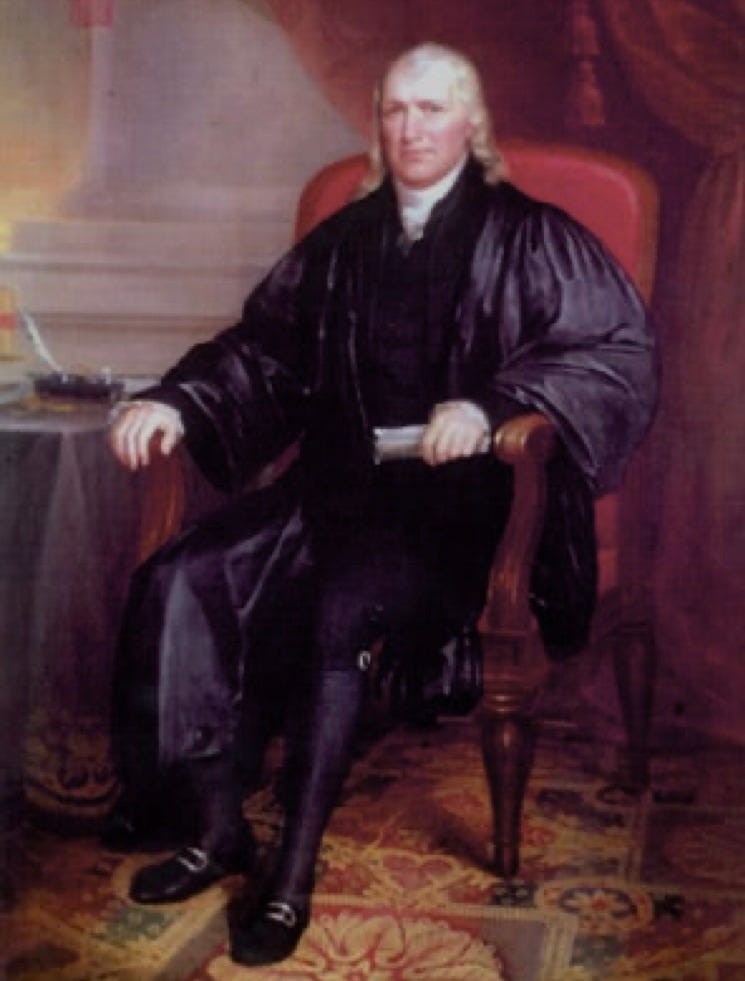An odd quirk of the original Constitution was its method for selecting the president and vice president. Electors did not distinguish in their votes between the president and vice president under article I, section 2, clause 3 of the Constitution. Instead each elector was free to vote for any two candidates they wished. The person who received a majority of the votes became president and the runner up became vice president.1
Modern Americans will identify the flaw in this set up immediately: the president and vice president will end up being members of opposite political parties and therefore unable to agree on anything. But when the Framers drafted the Constitution, they did not anticipate the two party system. Indeed, the term “party,” or “faction” as they often referred to it, was a four letter word at the Founding.
Yet despite the oft-stated antipathy of the Framers for political parties, two bitterly rivalrous factions, the Federalists and the Jeffersonian Republicans,2 nascent during the Washington Administration, emerged as soon as the Great Man exited the stage in order to contest the election of 1796. In the event, the Federalists swept the board, winning the presidency and majorities in both houses of Congress. But just as a modern observer would predict, the weird mechanism set up by the original Electoral College anomalously dropped the head of the opposition, Thomas Jefferson, into the vice presidency.
Although John Adams entered the presidency ostensibly opposed to “that fiend, the Spirit of Party,” he and his new vice president simply could not see eye-to-eye on the pressing questions of the day. This was the time of the “quasi-war,” an undeclared (mostly naval) conflict with Revolutionary France. The aristocratic Federalists were utterly appalled by the excesses of the French jacobins and heavily favored England in the ongoing European hostilities. Jefferson and his more egalitarian Republicans, on the other hand, supported the French Revolution.
In order to address what they perceived to be the enemies in their midst, the Federalist-dominated Congress enacted in 1798 the Alien and Sedition Acts. The numerous French spies and provocateurs supposedly lurking throughout the country were dealt with by three Alien Acts, which among other things gave the president unilateral authority to expel without due process any alien that he determined to be “dangerous to the peace and safety of the United States.”3 The Sedition Act, meanwhile, made it a crime to
write, print, utter or publish … any false, scandalous, and malicious writing or writings against the Government of the United States, or either House of the Congress of the United States, with intent to defame the said government, or either house of the said Congress, or the President, or to bring them … into contempt or disrepute, or to excite against them, or either or any of them, the hatred of the good people of the United States.
The sedition prosecutions
As Gordon Wood writes in Empire of Liberty, the press was becoming increasingly political and indeed partisan in the early years of the Republic:
[The press] began shedding its traditional neutral role of providing advertising, mercantile information, and foreign news to its readers. Editors … no longer saw themselves as merely tradesmen earning a living … instead, they became political advocates and party activists. During the course of the 1790s, these partisan editors, many of them immigrants, and their newspapers became essential to the emerging national parties of the Federalists and especially the Republicans.
The Republicans may have been the underdogs but their media game far out-matched that of the Federalists, who frankly found courting public opinion beneath them. As the Federalists saw it, the involvement of ordinary citizens in the political process ended at the ballot box, after which “they should remain quiet and uninvolved in politics until the next election.” Republicans, on the other hand, thought that since elected representatives in Congress could not be fully trusted to follow the wishes of their distant constituents, “newspapers … had a responsibility to protect the people’s liberties and promote their interests.”
The Sedition Act of 1798 was unabashedly aimed at protecting incumbent Federalists from the verbal slings and arrows of partisan media in the upcoming election. Notice, for example, the conspicuous omission of the vice president (Jefferson) from the list of officials protected from criticism by the Act. To make the point extra obvious, the legislation automatically sunset in 1800, at the end of Adams’s first term (thus providing no shield to a potential new Jefferson Administration from criticism by subsequently out of power Federalists).
Nevertheless, the Sedition Act was arguably an improvement over the common law crime of seditious libel, pursuant to which truth was not a defense, as Elkins and McKitrick describe in The Age of Federalism:
In the final version [of the Sedition Act], malicious intent had to be proved; evidence of the truth of the allegedly libelous utterances could be admitted as a defense; criticism of federal judges was eliminated from the scope of the law, leaving only criticism of Congress and the President; and the proviso was added that juries could determine not only the facts - as in traditional practice - but the law as well.4
The federal government arrested 25 people and brought 17 indictments for seditious libel (14 under the Sedition Act itself) and obtained 10 convictions against Republican authors and publishers in this period. The federal judiciary at the time was chock-full of Federalist judges and Republican defendants could not catch a break. The U.S. Supreme Court, meanwhile, never ruled on the constitutionality of the Sedition Act of 1798, because it lacked jurisdiction over criminal appeals from lower federal courts under the Judiciary Act of 1789.
In the most well known Sedition Act prosecution, U.S. v. Callender, the defense attorney attempted to present the law’s unconstitutionality to the jury, but was prevented by a confounding ruling from the presiding Circuit Justice, Samuel Chase.5 Callender’s lawyer argued that since the jury had authority to interpret the law, “and since the constitution is law, the conclusion is certainly syllogistic, that the jury ha[s] a right to consider the constitution.”

Obtusely, Justice Chase dismissed this obviously pertinent observation as a “non sequitur” and refused to allow the argument to be presented. Justice Chase was later impeached (though not convicted) for his role in Callender. So if Professor Amar is correct, the Founding generation screwed the Sixth Amendment pooch, in the interest of partisan advantage, by failing to allow the jury in Callender to consider the constitutionality of a federal criminal law. In Amar’s telling, the lion’s share of the Bill of Rights can be understood in terms of the constitutional right of juries to second guess judges.
Ultimately, the Sedition Act was mainly a self-own by the Federalists, because it made martyrs of savvy Republican political operators who went onto electoral success and more generally increased the Republicans’ popularity in the next election. The public’s disgust with the Sedition Act is widely credited with a significant role in the Federalist party’s subsequent total ouster from government in the federal election of 1800 as well as its shortly following demise.
The incoming Jefferson Administration allowed the Sedition Act to expire without attempting to renew it. Jefferson meanwhile pardoned those convicted of seditious libel by the Federalists and even secured legislation from Congress to refund their fines, on the basis of the Act’s unconstitutionality.
The populist First Amendment
In my last post I focused on the prior restraints doctrine as the likely inspiration for the First Amendment’s Free Speech Clause, but there is to be found in the common law canon another potential progenitor of free speech rights: parliamentary immunity. The 1689 English Bill of Rights provided that “the freedom of speech, and debates or proceedings in parliament, ought not to be impeached or questioned in any court or place out of parliament.”6
In England, free speech was thus a parliamentary privilege and not an individual right. As Professor Werhan observes, Englishmen “as subjects of the realm, were expected to content themselves with listening - silently - to that [parliamentary] debate.” But in the new United States, the mass of ordinary people were no longer subjects of a monarchal government, they were citizens of a republic. And as citizens, sovereignty ultimately lay with them, not with Congress, or with the government generally.
Professor Amar identifies a “deep popular-sovereignty logic underlying America’s extension of freedom of speech from Parliament to the people.” When we, the people discuss and debate matters of public concern, we are exercising a sovereign prerogative and enjoy the same immunities as legislators, who after all are merely our proxies in the legislative process. To suppose that the people’s representatives in Congress could curtail the sovereign right of the people to review the performance of those very representatives gets that relationship precisely backwards.
For Amar then, the story of the Sedition Act of 1798 is an object lesson in the populist power of the First Amendment. Indeed, he sees the Revolution of 1800 as a “poetic” vindication of popular sovereignty:
No court invalidated the Alien and Sedition Acts … Rather, a popular majority adjudicated the First Amendment question in the election of 1800, by throwing out the haughty and aristocratic rascals who had tried to shield themselves from popular criticism.
As the U.S. Supreme Court recognized in the twentieth century in New York Times v. Sullivan, the verdict of history has agreed with the voters of 1800 that the Adams Administration got the First Amendment wrong with the 1798 Sedition Act. But the expiration of the Act did not herald an era of robust speech protection in America. Seditious libel remained a crime in the states. Indeed, Republican-allied state prosecutors subsequently brought indictments under state law for that very offense against Federalists critical of the new regime, while Jefferson whistled.
So at most, the judgment of 1800 was one of federalism: Congress lacked the power to punish speech, because that was the province of the states. Nor can it even be said that the federal government had learned its lesson. The 1798 law would not be the last federal Sedition Act in American history.
This system was soon altered by the Twelfth Amendment in 1804, after the nation narrowly evaded a constitutional crisis when Jefferson got the same number of votes as Aaron Burr in the election of 1800.
I’m referring to this early Republican party as the “Jeffersonian” Republicans to distinguish it from the later GOP, a separate product of the late antebellum period.
As the former president recently observed, the Alien Enemies Act of 1789 is technically still on the books.
I don’t agree with Elkins and McKitrick, however, that questions of law were traditionally kept from juries in the eighteenth century, as I discussed last time. But it could be said that the Sedition Act codified the rule established in Crown v. Zenger in this regard.
Not to be confused with the later Chief Justice Salmon P. Chase, author of White v. Texas, which I previously examined. In this era, the justices of the Supreme Court spent most of their time “riding circuit,” meaning travelling across the country to preside in lower court proceedings.
Our Constitution similarly contains a Speech and Debate Clause, which protects members of Congress from reprisals for comments made in either house.



